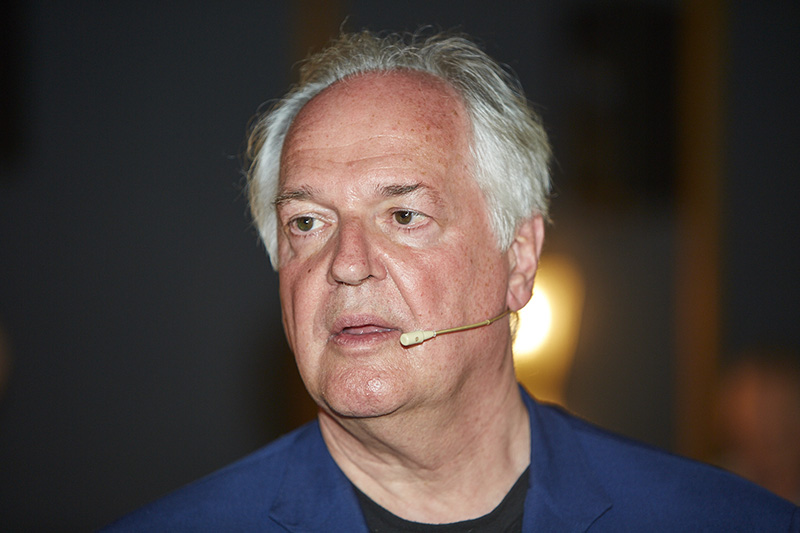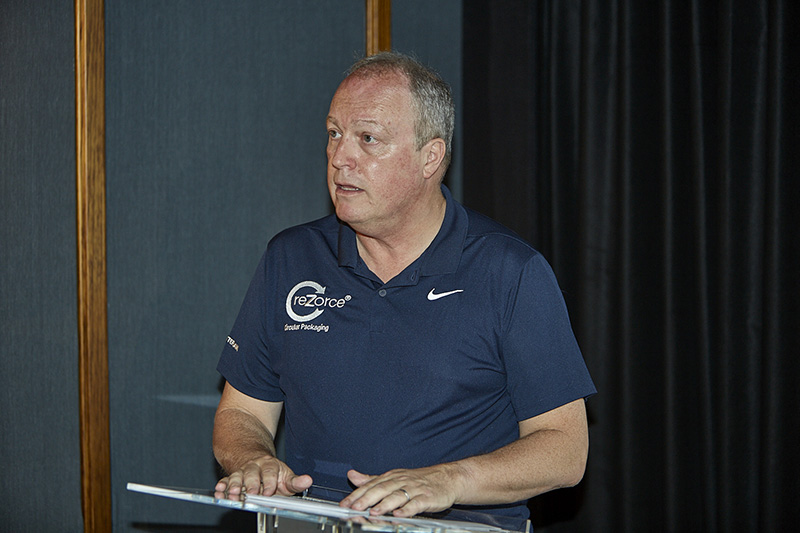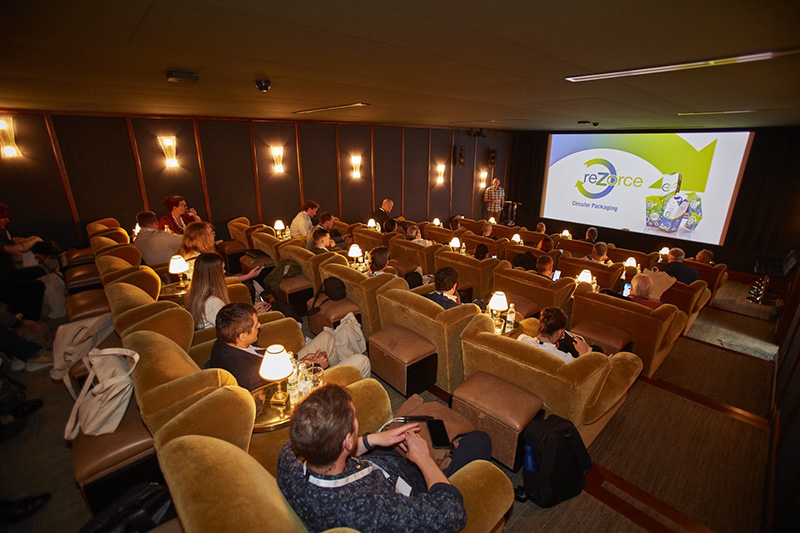Packaging Scotland’s Craig Quirie reports from Amsterdam, where Croydon-based Zotefoams provided an update on the commercialisation of its ‘once-in-a-generation’ packaging innovation, which is set to be trialled in a Dutch supermarket
AMSTERDAM was the international meeting point for the official update on the progress made in the commercialisation of a solution that has been heralded as a ‘once-in-a-generation’ packaging innovation.
Joined by key packaging sector stakeholders and fellow media professionals, I took my rather luxurious seat in the Dutch capital’s prestigious Soho House to not just hear Zotefoams’ update on its ReZorce innovation but also witness genuine industry titans endorse the solution – both from a commercial and environmental standpoint.
The HDPE mono-material alternative to liquid packaging board beverage cartons is a layered structure that offers barrier properties comparable with those of multi-material aseptic packaging used widely in the food and beverage sector.
Crucially, it has ‘outstanding’ recyclability, and its structure enables the incorporation of post-consumer recyclate in the core of the material with virgin polymer on the outer surfaces, meaning ReZorce beverage cartons simultaneously meet food safety regulations and deliver against the targets for recycled content set out in the EU Packaging & Packaging Waste Directive.
The Amsterdam update revealed ReZorce cartons are now being produced at one of Refresco’s facilities in Europe with a machine designed for traditional composite beverage cartons, modified with a proprietary change parts kit. The companies are also initiating quality and compliance testing procedures required for commercial production of beverage carton applications.
Zotefoams also confirmed an agreement had been made with Südpack, a leader in polymer extrusion, to provide a potential capacity of up to 100 million ReZorce cartons annually. Believing it will be able to scale ReZorce quickly thanks to its extrusion capabilities, Südpack MD Dirk Hardow explained that such solutions – combined with proper recycling offerings – can ‘reshape’ the future of plastics.
With the updates signalling the nearing of ReZorce being greenlighted for commercial trials, the solution will enter the testing period having already gained the seal of approval of industry heavyweights including Paul Polman, who revealed that it would be a solution he’d have looked to utilise had it been around during his time of leading Unilever from 2009 until 2019.

Paul, who spearheaded the global organisation in transforming its factories to zero waste and authored the award-winning book Net Positive, was joined in his support by Chris Hanlon, Biffa’s commercial director for polymers.
Stating the recycling specialist ‘strongly encourages’ simple packaging mono structures that are easy to recycle and fit in with current infrastructure, Chris added that ReZorce being designed with ‘recyclability in mind’ is why Biffa is so interested in the solution.
The three-hour event featured a plethora of speeches, debates, and Q&As, which left those in attendance in no doubt of the scale of the innovation and its potential impact in helping to address some major challenges.
However, it was at the evening dinner I was most struck. Held in the hotel’s plush Allis Bar, with dishes served from a local restaurant, I was able to interact with the Zotefoams team in a more relaxed environment – and what was immediately clear was how much the solution meant to them as humans.
Zotefoams is not a packaging company; it is a science-based disrupter intent on delivering innovation and solutions. Previous work has included the creation of ZoomX foam used in Nike running shoes, that helped propel athletes to world records and first place finishes.
“We are pioneers of material science; that’s what we live for,” Neil Court-Johnston, president of Zotefoams’ Mucell division, explained. “It’s all about innovation and that’s what drives our team.”

The decision to launch in the carton market was partly fuelled by the design of such containers having fundamentally remained the same since the early 1950s.
“There were quite a few markets we could have gone into, but we felt this was the most impactful,” David Stirling continued, adding that delivering a solution that benefits society was a ‘fairly major’ motivator in ReZorce’s development.
Hailing from Glasgow, David joined Croydon-based Zotefoams in 1997 as financial director before becoming CEO in 2000 and leading the company to operations in Europe, North America, and Asia prior to his retirement from the role in May this year.

“It’s certainly the biggest bet the company has placed – financially and in terms of time and effort,” David replied, when asked where ReZorce stands in terms of milestones throughout his tenure. “I think it’s also the biggest opportunity. Let’s face it, we’re a 600-people company trying to disrupt a multi-billion pound/dollar/euro industry – not many people get a chance to do that.”
Reiterating the confidence he has in the Zotefoams team in embracing the challenge, David said the company has never been intimidated by the fact no one else has created, or appears to be creating, a solution like ReZorce.
“The reality is, it’s such a big market that we’re not necessarily going to be the only solution in it. But we don’t need to be the only solution – we just need to be a viable solution that a percentage of the market picks up.”
During the early development of ReZorce, Zotefoams approached 30 brands and retailers across Europe as part of an exercise to gauge interest levels. 29 said they were definitely interested, with the lone outlier returning six months later saying it had changed its mind.
“If we had five out of 30 interested, we’d still have gone ahead,” David revealed. “That’s still a massive part of the market. We’re not necessarily saying we need 100% market share – it’s about partnering with the correct fits.”

The same selective approach was taken in curating the 22 partners to develop ReZorce, with Neil Court-Johnston dubbing it an ‘ecosystem of world class businesses and experts’ made up of organisations, individuals, and learning institutions across the globe.
Revealing that his rejection of potential partners was probably ‘quite frustrating’ at times for the team, David explained how focus can shift at the hands of the wrong partner – with everyone in the current line-up pulling in the same direction.
“You also need partners to challenge you and say, ‘you can’t do this’ or ‘this doesn’t make sense’ – you want partners to give you a reality check, rather than saying what we want to hear,” he continued.
The partnerships are not just centred on the development of ReZorce, but also transparency and education – particularly around the perception held by some that all plastic packaging is inherently bad. RECOUP, the independent authority on plastics resource efficiency and recycling, is hoped to be key to this.
“We’ve got the RECOUP guys (doing audits); we’ve got the transparency, and we’re doing it properly because that’s the way society is heading,” David explained. “People of my kids’ generation are much more savvy about sustainability – they’re much more interested in the facts rather than ‘the pack says it’s cool, so it’s cool’. That doesn’t wash anymore, and that’s good.”
Featuring QR codes, the ReZorce packs will lead consumers directly to information such as the entire lifecycle of the polymer in the carton, as well as additional details including carbon footprint calculators and ingredients.
Brands will be able to present their product in designs familiar to customers, with the digital printing offering also enabling for a batch size of one product being produced and design changes ‘right up to the wire’ – meaning companies won’t have to have packaging plans cemented months in advance of events such as Halloween or Christmas.
The compatibility with existing infrastructure means production can be localised, including to lower volume production lines closer to the consumer or filling line. Day one launch will see such outsourcing, with David explaining the medium-term plan is to see multiple different print offerings – including to the point of a removable layer, which is preferred by recyclers due to it leaving a plain carton once peeled off.
The familiarity that such branding brings about is hoped to result in environmental benefits as well as commercial.
“The reason LPB has been so successful is because consumers like it, retailers like it, brands like it – it’s a square pack, has great packing density, and has a big front that is easy to print on,” David explained.
“We’re keeping all of that – just treat it like a milk carton; chuck it in the recycling bin and it will be recycled and, not only will it be recycled, but recycled into another pack.”
Development of ReZorce will continue to accelerate as preparations gather pace for a trial of 150,000 cartons in a major Dutch supermarket chain by the end of the year, with it set to be merchandised immediately adjacent to current liquid board packaging to test how consumers interact with the two different materials.
Upon holding a filled ReZorce carton, my first thoughts were that it was sturdy and unlikely to burst if dropped or when in transit. It also didn’t strike me as being anything out of the ordinary, which I believe to be important as consumers are becoming more sceptical of alternative packaging advancements after experiences of paper bags collapsing or food products spoiling early.
















